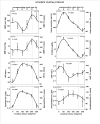Existence of an endogenous circadian blood pressure rhythm in humans that peaks in the evening
- PMID: 21474818
- PMCID: PMC3086568
- DOI: 10.1161/CIRCRESAHA.110.233668
Existence of an endogenous circadian blood pressure rhythm in humans that peaks in the evening
Abstract
Rationale: Blood pressure (BP) usually decreases during nocturnal sleep and increases during daytime activities. Whether the endogenous circadian control system contributes to this daily BP variation has not been determined under appropriately controlled conditions.
Objective: To determine whether there exists an endogenous circadian rhythm of BP in humans.
Methods and results: In 28 normotensive adults (16 men), we assessed BP across 3 complementary, multiday, in-laboratory protocols performed in dim light, throughout which behavioral and environmental influences were controlled and/or uniformly distributed across the circadian cycle via: (1) a 38-hour "constant routine," including continuous wakefulness; (2) a 196-hour "forced desynchrony" with 7 recurring 28-hour sleep/wake cycles; and (3) a 240-hour forced desynchrony with 12 recurring 20-hour sleep/wake cycles. Circadian phases were derived from core body temperature. Each protocol revealed significant circadian rhythms in systolic and diastolic BP, with almost identical rhythm profiles among protocols. The peak-to-trough amplitudes were 3 to 6 mm Hg for systolic BP and 2 to 3 mm Hg for diastolic BP (always P<0.05). All 6 peaks (systolic and diastolic BP in 3 protocols) occurred at a circadian phase corresponding to ≈9:00 pm (ie, the biological evening). Based on substantial phase differences among circadian rhythms of BP and other variables, the rhythm in BP appeared to be unrelated to circadian rhythms in cortisol, catecholamines, cardiac vagal modulation, heart rate, or urine flow.
Conclusions: There exists a robust endogenous circadian rhythm in BP. The highest BP occurred at the circadian time corresponding to ≈9:00 pm, suggesting that the endogenous BP rhythm is unlikely to underlie the well-documented morning peak in adverse cardiovascular events.
Figures



References
-
- Marler JR, Price TR, Clark GL, Muller JE, Robertson T, Mohr JP, Hier DB, Wolf PA, Caplan LR, Foulkes MA. Morning increase in onset of ischemic stroke. Stroke. 1989;20:473–476. - PubMed
-
- Muller JE, Muller JE, Stone PH, Turi ZG, Rutherford JD, Czeisler CA, Parker C, Poole WK, Passamani E, Roberts R, Robertson T, Sobel BE, Willerson JT, Braunwald E MILIS Study Group. Circadian variation in the frequency of onset of acute myocardial infarction. N Engl J Med. 1985;313:1315–1322. - PubMed
-
- Shea SA, Hilton MF, Muller JE. Day/Night Patterns of Myocardial Infarction and Sudden Cardiac Death: Interacting Roles of the Endogenous Circadian System and Behavioral Triggers. In: White WB, editor. Blood Pressure Monitoring in Cardiovascular Medicine and Therapeutics. Humana Press; 2007. pp. 251–289.
-
- Kalsbeek A, Palm IF, La Fleur SE, Scheer FA, Perreau-Lenz S, Ruiter M, Kreier F, Cailotto C, Buijs RM. SCN outputs and the hypothalamic balance of life. J Biol Rhythms. 2006;21:458–469. - PubMed
-
- Scheer FA, Kalsbeek A, Buijs RM. Cardiovascular control by the suprachiasmatic nucleus: neural and neuroendocrine mechanisms in human and rat. Biol Chem. 2003;384:697–709. - PubMed
Publication types
MeSH terms
Grants and funding
LinkOut - more resources
Full Text Sources
Other Literature Sources

